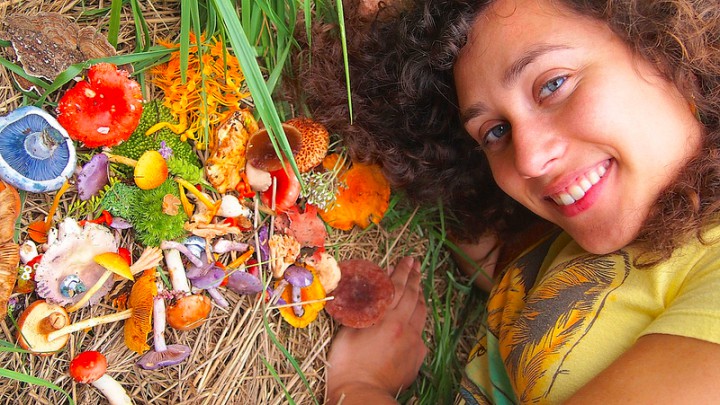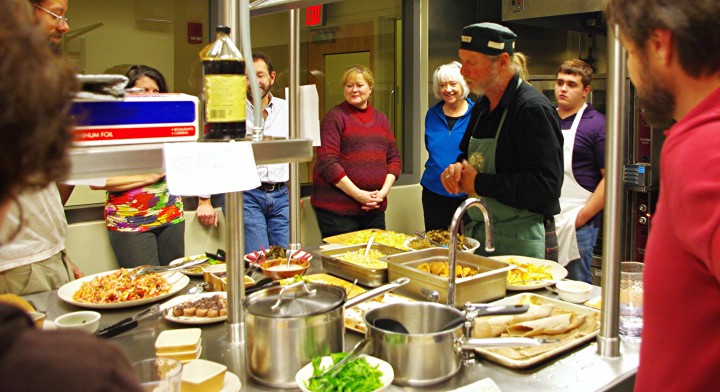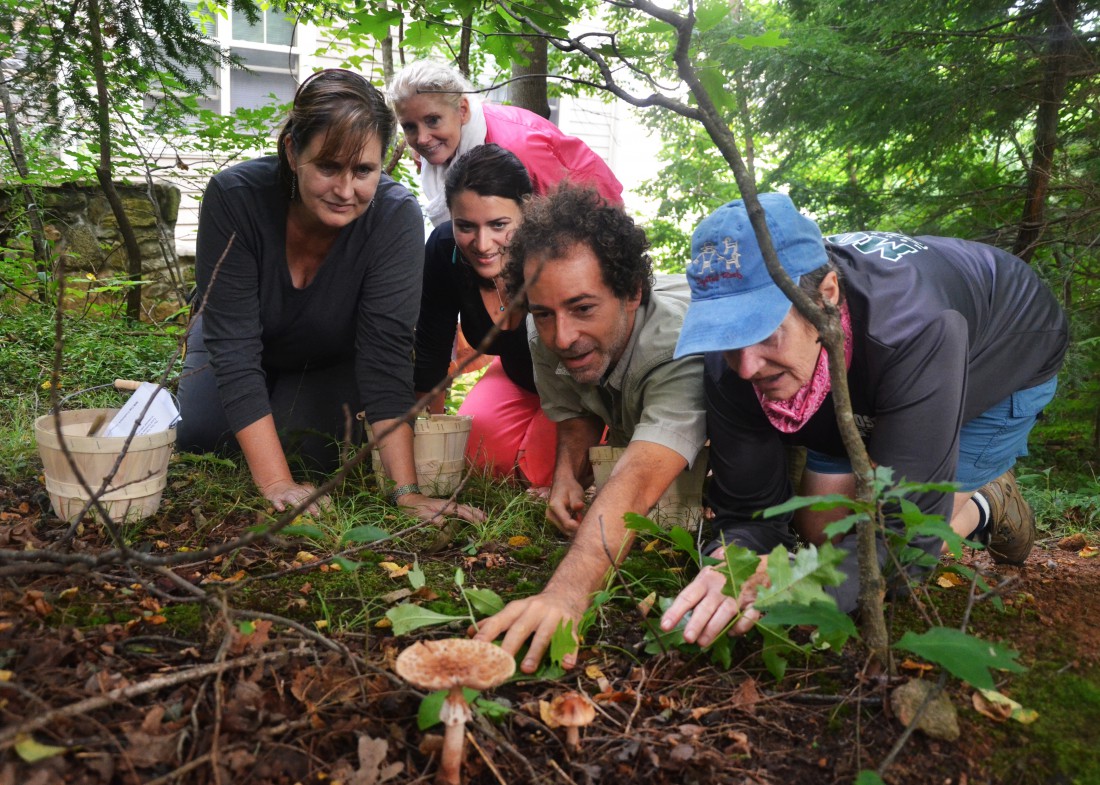Mark-Ellis Bennett contributed to this report
Local forager Alan Muskat leads a group of public school kids through a wooded area of Western North Carolina not too far from town. They search for greens, nuts, berries and mushrooms — and unexpectedly stumble upon an abandoned apple orchard, abundant with ripe, red apples.
“One kid picked up an apple from the ground and said, ‘Are you sure we can eat this?’” Muskat says. “I asked him what he meant, and he said, ‘Well, this was on the ground.’ It was so empowering that he could get his own food and that it wasn’t poisonous or dirty because it touched the ground.”
Muskat says Western North Carolina features the greatest variety of flora and fauna north of the tropics, which makes Asheville an ideal place for those who forage for food. In fact, foraging can begin as close as your own backyard — where edible plants like chickweed, lamb’s quarters, dandelion greens, bitter cress, wild onions, purslane and nettles are often mistaken for weeds.
“People have a fear of [foraging] because it’s not part of our culture,” says Muskat, who runs the educational nonprofit No Taste Like Home and has appeared on the Travel Channel’s Bizarre Foods with Andrew Zimmern — where Muskat taught the show’s host that the first lesson of foraging is “to keep your eyes open.”
Foraging, after all, “isn’t any more difficult than going to a grocery store and learning to distinguish cabbage from iceberg lettuce,” says Muskat.
Knowledge Before Action
Natalie Bogwalker takes foraging to the extreme. As founder and instructor for the organization Wild Abundance, she teaches people to live self-sufficiently, entirely off the land. She teaches adults and children about eco-homesteading, primitive skills, permaculture and connecting with nature in everyday life.
“I started foraging when I was about 4 years old with my dad,” says Bogwalker. “I’ve always just really liked being in the woods, and very little makes me as excited as getting food from the wild.”
But, Bogwalker says, “it’s not just in the woods that I find food, but also where the wild meets the domesticated.”
For foraging, Bogwalker recommends knowledge before action and making sure you can tell the difference between edible, medicinal and toxic plants.
“There are a small number of green plants to stay away from, mostly in the carrot family,” Bogwalker says. “I tend to only harvest a few species of mushrooms that are incredibly easy to distinguish from the toxic varieties. There are many varieties that are quite toxic.”
And there’s little doubt that foraging wild species can be a bit dangerous — which is why many expert foragers, like Muskat, really encourage education.
”It’s like riding a bike or driving a car. Someone teaches us, [but] that’s still dangerous, right?” Muskat says. “If we hunted mushrooms in this country as normally as we watch TV or play a video game, everyone would be an expert at it.”
In most cultures around the world, he adds, children learn about collecting food with their parents. In lieu of that, Muskat is hoping to teach local kids about foraging through the Afikomen Project, which he started at Asheville Middle School in 2012. He hopes the program will expand to public schools across the country.
“Our goal is to have, by 2030, every child in the United States able to safely identify and harvest the 10 most common wild foods in their area,” he says.
Muskat guides foraging tours and founded the first forage-to-table program in the United States and the first wild foods market in North America. For those interested in safe ways to learn about foraging mushrooms and other wild foods, he recommends hands-on, expert-directed learning.
“The only word you need to remember has three letters, and it’s ‘ask,’” Muskat says.
A good place to start? Muskat suggests the George Washington Carver Edible Park near the Stephens-Lee Recreation Center downtown. “You wouldn’t typically find mushrooms there, but there are other wild foods and over a dozen cultivated fruit trees,” Muskat says.
But, both Muskat and Bogwalker say, once you learn more about foraging, you’ll find plenty not far from your front door.
“Pretty much around anybody’s house anywhere there’s going to be some basic things,” says Bogwalker, who says she likes to forage greens to make wild salads. “There’s going to be chickweed, dandelion greens, dock greens — there’s all sorts of things available where you live all the time.”
Muskat adds, “Five feet, you know, 10 feet from my front door, and I’m nibbling on dandelion and onion grass and bitter cress.”

Venturing into the woods
If you’re thinking about taking your journey into foraging into the woods, however, make sure you know the rules — and have your permit handy — before exploring along the Blue Ridge Parkway or venturing onto U.S. Forest Service property. Permits are required to harvest ginseng, black cohosh, bloodroot and other medicinal plants and roots, each with specific restrictions and prices per pound, according to the Forest Service manual.
You can collect up to 5 pounds of popular ramps per season without a permit, though the Forest Service encourages applying for a Free Use Permit. That helps rangers keep track of how many people are collecting them. Fruits, berries and mushrooms can also be foraged for personal use without a permit — though some polite restraint is encouraged.
“People need to make sure they leave plants behind for future years. That’s called sustainability,” says Public Affairs Officer Stevin Westcott.
According to a Forest Service handbook, there are plenty of edibles to find on the Blue Ridge Parkway: mushrooms and related edible fungi, strawberries, blackberries, raspberries, wine berries, blueberries, elderberries, huckleberries, gooseberries, serviceberries, currants, grapes, cherries, plums, persimmons, black walnuts, hickory nuts, American hazelnuts, apples, peaches and pears.
You’re allowed up to one gallon per person, per day, though respect and caution are a must. Climbing trees to gather these edibles is prohibited and straying off the trails can cause damage to delicate and rare plants and increase the risk of erosion.

Enjoying the adventure
If you’re looking for some tips on how to prepare a feast from your foraged harvest, you can ask the “Sustainable Gourmet” aka Michael Gentry. He teaches students at UNC Asheville how to prepare and consume a vegetarian meal made with organic and wild ingredients.
“I harvest most of the vegetables myself from Warren Wilson College,” says Gentry. He also likes to showcase new foods featured in local stores “so we can try those out, [but] I also harvest something wild from Mother Nature to include in my meal.”
Another tip for foraging? Make it a social activity. Gentry says that he likes to forage with the Asheville Mushroom Club. “We go on forays all over WNC and in Tennessee,” Gentry says, adding that the club meets March through November.
Other Asheville clubs include the Buncombe Fruit and Nut Club, which plants and maintain a wide variety of trees and bushes in public parks and schoolyards throughout the city and county. Member Bill Whipple says there’s everything from the ABCs (apples, blueberries and cherries) to Ziziphus jujube, otherwise known as the Chinese date, though hazelnuts are his favorite.
“When you come to one of the edible parks, the best way to engage foraging is to gently shake a tree with ripe fruit and pick up one or two that fall,” Whipple says. “But don’t come with boxes or bags. Leave plenty for the next guy.”
Bogwalker, meanwhile, is currently working on a book that may provide some helpful insight for regional residents on how to prepare and forage for foods. Her book, Preparation and Preservation: A Guide to the Wild Abundance of Southern Appalachia and Beyond, will include gathering tips, preservation and fresh recipes and stories featuring 40 common wild foods in the area.
Muskat recommends the blog Transitional Gastronomy for ideas on how to prepare found foods. “We have one of the most diverse places on the entire planet in Asheville, so you could make whole meals,” he adds.
Ultimately, Muskat says, the great thing about foraging is how easy and accessible it can be. “The only preparation you need is some familiarity,” Muskat says. “You don’t have to put anything special on. You don’t need any equipment.”
And best of all, Muskat adds, “You don’t have to go far.”





Before you comment
The comments section is here to provide a platform for civil dialogue on the issues we face together as a local community. Xpress is committed to offering this platform for all voices, but when the tone of the discussion gets nasty or strays off topic, we believe many people choose not to participate. Xpress editors are determined to moderate comments to ensure a constructive interchange is maintained. All comments judged not to be in keeping with the spirit of civil discourse will be removed and repeat violators will be banned. See here for our terms of service. Thank you for being part of this effort to promote respectful discussion.